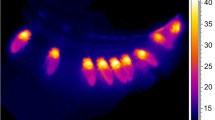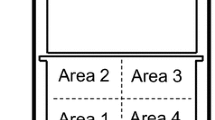Summary
Honeybees often abandon non-depleting food sources with a partially filled crop. This behaviour does not maximise the net rate of energy extraction from the food sources, and thus contradicts predictions of some common models for central place foragers. We show that including the metabolic costs of transport of nectar leads to models that predict partial crop-loading. Furthermore, the observed crop loads of honeybees are less consistent with those predicted by maximization of delivery rate to the hive (net energetic gain/ unit time), than with those predicted by maximization of energetic efficiency (net energetic gain/unit energy expenditure). We argue that maximization of energetic efficiency may be an adaptation to a limited flight-cost budget. This constraint is to be expected because a worker's condition seems to deteriorate as a function of the amount of flight performed.
Similar content being viewed by others
References
Bastian J, Esch H (1970) The nervous control of the indirect flight muscles of the honey bee. Z Vergl Physiol 67:307–324
Benedictis PA De, Gill FB, Hainsworth FR, Pyke GH, Wolf LL (1978) Optimal meal size in hummingbirds. Am Nat 112:301–316
Beutler R (1937) Über den Blutzucker der Bienen. Z Vergl Physiol 24:76–115
Boch R (1956) Die Tänze der Bienen bei nahen und fernen Trachtquellen. Z Vergl Physiol 38:136–167
Cheverton J, Kacelnik A, Krebs JR (1985) Optimal foraging: constraints and currencies. In: Hölldobler B, Lindauer M (eds) Experimental behavioral ecology and sociobiology. Fortschr Zool 31:109–126
Frisch K von (1965) Tanzsprache und Orientierung der Bienen. Springer, Berlin Heidelberg New York
Heinrich B (1975) Thermoregulation by bumblebees. II. Energetics of warm-up and free flight. J Comp Physiol 96:155–166
Heinrich B (1979) Keeping a cool head: honeybee thermoregulation. Science 205:1269–1271
Heran H (1962) Wie beeinflußt eine zusätzliche Last die Fluggeschwindigkeit der Honigbiene? Verh Dtsch Zool Ges 1962:346–354
Hodges CM (1981) Optimal foraging in bumblebees: Hunting by expectation. Anim Behav 29:1166–1171
Jongbloed J, Wiersma CAG (1934) Der Stofwechsel der Honigbiene während des Fliegens. Z Vergl Physiol 21:519–533
Kacelnik A (1984) Central place foraging in starlings (Sturnus vulgaris). I. patch residence time. J Anim Ecol 53:283–300
Kacelnik A, Houston AI (1984) Some effects of energy costs on foraging strategies. Anim Behav 32:609–614
Kosmin NP, Alpaton WW, Resnitschenko MS (1932) Zur Kenntnis des Gaswechsels und des Energieverbrauchs der Biene in Beziehung zu deren Aktivität. Z Vergl Physiol 17:408–422
Lindauer M (1952) Ein Beitrag zur Frage der Arbeitsteilung im Bienenstaat. Z Vergl Physiol 34:299–345
Lindauer M (1954) Temperaturregulierung und Wasserhaushalt im Bienenstaat. Z Vergl Physiol 36:391–432
Lucas JR (1983) The role of foraging constraints and variable prey encounter in optimal diet choice. Am Nat 122:191–209
Michener CD (1974) The social behavior of the bees. Belknap, Harvard University, Cambridge, Mass
Neukirch A(1982) Dependence of the life span of the honeybee (Apis mellifera) upon flight performance and energy consumption. J Comp Physiol 146:35–40
Nuñez J (1970) The relationship between sugar flow and foraging and recruiting behavior of honey bees (Apis mellifera L.). Anim Behav 18:527–538
Nuñez J (1974) Metabolism and activity of the worker bee. Proc 24th Int Beekeep Congr, Buenos Aires, pp 298–299
Nuñez J (1982) Honeybee foraging strategies at a food source in relation to its distance from the hive and the rate of sugar flow. J Apic Res 21:139–150
Orians GH, Pearson NE (1979) On the theory of central place foraging. In: Horn DJ, Stairs GR,Mitchell RD (eds) Analysis of ecological systems. Ohio University Press
Oster GF, Wilson EO (1978) Caste and ecology in the social insects. Monographs in population biology, vol 12. Princeton University Press, Princeton, NJ
Pyke GH (1978) Optimal foraging in bumblebees and coevolution with their plants. Oecologia (Berl) 36:281–293
Rothe U (1983) Stoffwechselphysiologische Untersuchungen an ruhenden, laufenden und fliegenden Honigbienen (Apis mellifera carnica). Ph D thesis, Universität Saarbrücken
Scholze E, Pichler H, Heran H (1964) Zur Entfernungsschätzung der Bienen nach dem Kraftaufwand. Naturwissenschaften 3:69–70
Seeley TD (1985) The information-center strategy of the honeybee. In: Hölldobler B, Lindauer M (eds) Experimental behavioral ecology and sociobiology. Fortschr Zool 31:75–90
Sotavolta O (1954) On the fuel consumption of the honeybee (Apis mellifica L.) in flight experiments. Ann Zool Soc Vanamo 16:1–27
Waddington KD, Holden LR (1979) Optimal foraging: On flower selection by bees. Am Nat 114:179–196
Withers P (1981) The effect of ambient air pressure on oxygen consumption of resting and hovering honeybees. J Comp Physiol 141:433–437
Author information
Authors and Affiliations
Rights and permissions
About this article
Cite this article
Schmid-Hempel, P., Kacelnik, A. & Houston, A.I. Honeybees maximize efficiency by not filling their crop. Behav Ecol Sociobiol 17, 61–66 (1985). https://doi.org/10.1007/BF00299430
Received:
Accepted:
Issue Date:
DOI: https://doi.org/10.1007/BF00299430




